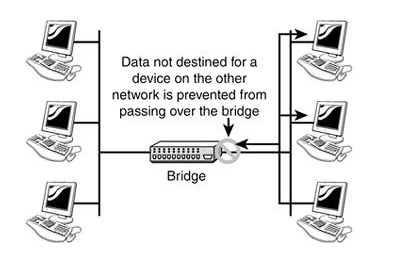What is Hub, Bridge, Router & Switch in Networking?
Hubs

Image: Hub and wireless hub network icons
In a hub, a frame is passed along or “broadcast” to every one of its ports. It doesn’t matter that the frame is only destined for one port. The hub has no way of distinguishing which port a frame should be sent to. Passing it along to every port ensures that it will reach its intended destination. This places a lot of traffic on the network and can lead to poor network response times
A hub is a physical layer networking device which is used to connect multiple devices in a network. They are generally used to connect computers in a LAN.
A hub has many ports in it. A computer which intends to be connected to the network is plugged in to one of these ports. When a data frame arrives at a port, it is broadcast to every other port, without considering whether it is destined for a particular destination or not.
Usage:-
Now suppose that your office issues you a laptop, and you want to be able to telecommute (work from home) at times. Because you already have an Internet connection to your home, you might want to share that connection, rather than install a second connection for your laptop; a small hub enables you share this connection, as illustrated in Figure.
Bridge
Working Principle
The working principle of a bridge is, it blocks or forwards the data depending on the destination MAC address and this address is written into every data frame.

In a computer network, a bridge separates a LAN into different segments like segment1 & segment2, etc and the MAC address of all the PCs can be stored into the table. For instance, PC1 transmits the data to PC2, where the data will transmit to the bridge first. So the bridge reads the MAC address & decides whether to transmit the data to segment1 or segment2. Therefore, the PC2 is accessible in segment1, which means the bridge transmits the data in segment1 only & eliminates all the connected PCs in segment2. In this way, the bridge reduces traffic in a computer network.
Types of Bridges
Transparent Bridge
Translational Bridge
Source-route Bridge
Functions of Bridges in Network
Advantages/Disadvantages of Bridge in Computer Network
The advantages are
- It acts as a repeater to extend a network
- Network traffic on a segment can be reduced by subdividing it into network communications
- Collisions can be reduced.
- Some types of bridges connect the networks with the help of architectures & types of media.
- Bridges increase the available bandwidth to individual nodes because fewer network nodes share a collision domain
- It avoids waste BW (bandwidth)
- The length of the network can be increased.
- Connects different segments of network transmission
The disadvantages are
- It is unable to read specific IP addresses because they are more troubled with the MAC addresses.
- They cannot help while building the network between the different architectures of networks.
- It transfers all kinds of broadcast messages, so they are incapable to stop the scope of messages.
- These are expensive as we compare with repeaters
- It doesn’t handle more variable & complex data load which occurs from WAN.
Router
Features of Routers
A router is a layer 3 or network layer device.
It connects different networks together and sends data packets from one network to another.
A router can be used both in LANs (Local Area Networks) and WANs (Wide Area Networks).
It transfers data in the form of IP packets. In order to transmit data, it uses IP address mentioned in the destination field of the IP packet.
Routers have a routing table in it that is refreshed periodically according to the changes in the network. In order to transmit data packets, it consults the table and uses a routing protocol.
In order to prepare or refresh the routing table, routers share information among each other.
Routers provide protection against broadcast storms.
Routers are more expensive than other networking devices like hubs,bridges and switches.
Routing Table
The functioning of a router depends largely upon the routing table stored in it. The routing table stores the available routes for all destinations. The router consults the routing table to determine the optimal route through which the data packets can be sent.
A routing table typically contains the following entities −
- IP addresses and subnet mask of the nodes in the network
- IP addresses of the routers in the network
- Interface information among the network devices and channels
Routing tables are of two types −
Static Routing Table − Here, the routes are fed manually and are not refreshed automatically. It is suitable for small networks containing 2-3 routers.
Dynamic Routing Table − Here, the router communicates with other routers using routing protocols to determine the available routes. It is suited for larger networks having large number of routers.
Difference b/w Switch and Hub
What is a Switch?
A network switch is a computer networking device that connects various devices together on a single computer network. It may also be used to route information in the form of electronic data sent over networks. Since the process of linking network segments is also called bridging, switches are usually referred to as bridging devices.
What is Hub?
A Hub is a networking device that allows you to connect multiple PCs to a single network. It is used to connect segments of a LAN. A hub stores various ports, so when a packet arrives at one port, it is copied to various other ports. Hub works as a common connection point for devices in a network.
Thanks For Reading

















This is the useful information, Keep growing.
ReplyDelete